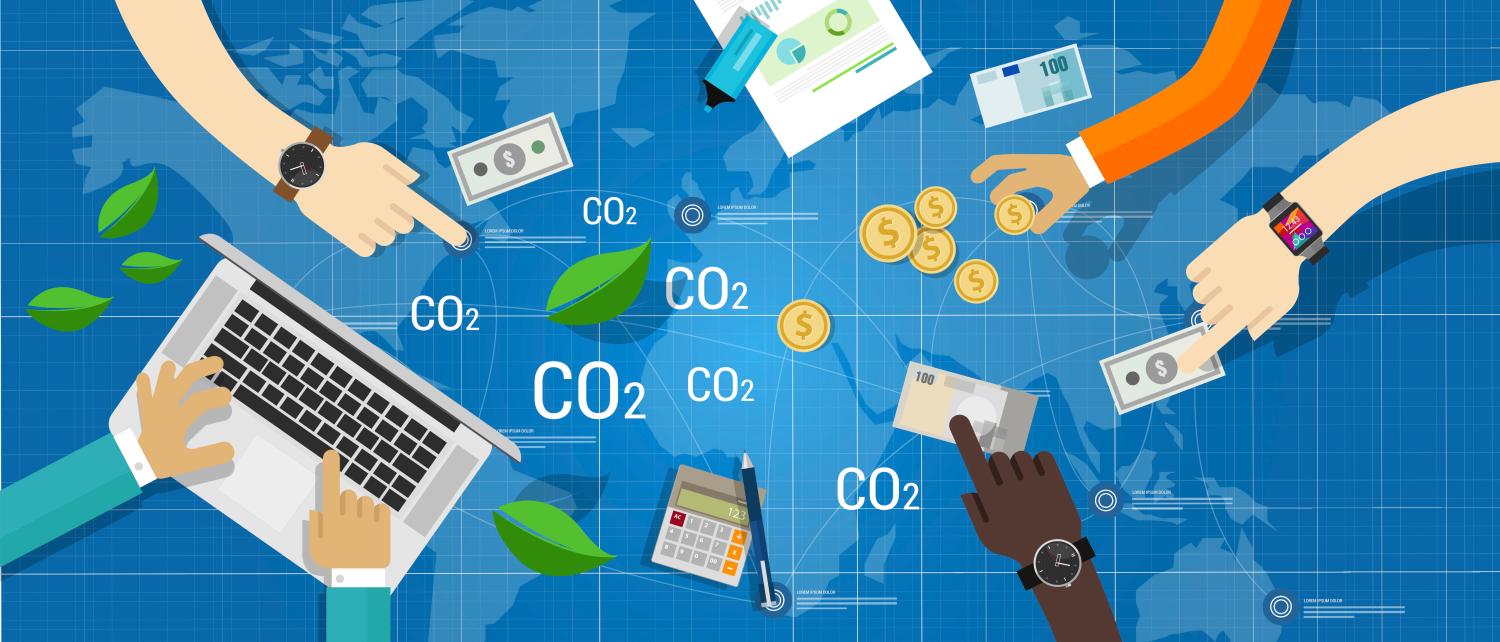Given the number and increasing severity of climate-related events, combating climate change is urgent. Under the auspices of the United Nations Climate Change Secretariat, members of its Conference of Parties (COP) agreed that nations would take actions to limit emissions of greenhouse gases (carbon dioxide, methane, nitrous oxide, and various fluorinated gases, often conveniently lumped together as “carbon”) to keep global temperatures from rising, ideally by no more than 1.5 degrees centigrade but more realistically 2 degrees centigrade, above pre-industrial levels by 2100. Meeting this goal requires global annual carbon emissions to be cut by 50 percent by 2030 and reduced to net-zero by 2050.
Yet even these cuts may not be enough. Even with the latest announced plans by some countries to adopt more stringent climate measures, the Climate Action Tracker—a widely respected nongovernmental organization—projects that global temperatures would increase by 2.4 degrees C by 2100, well above the Paris target for 2050 (Climate Action Tracker, 2021). The UN-mandated Intergovernmental Panel on Climate Change (IPCC) was even more pessimistic, projecting that even with national commitments to reduce emissions, global temperatures are projected to rise by at least 3 degrees C above 1900 levels by the end of the century, with potentially catastrophic impacts, including even more extreme weather events and rapid sea level rise (IPCC, 2021).
One way to reduce carbon emissions is to tax carbon or put a cap on carbon emissions by polluters and allow them to trade those permits. Such so-called “compliance carbon markets” have the effect of inducing those able of most inexpensively reducing carbon emissions—or to capture it from the atmosphere or oceans—to do so.
Over the past several years, efforts have been made by various companies to establish voluntary carbon markets (VCMs) that, supporters say, in principle can be as or nearly as effective as compliance markets. VCMs are venues—exchanges or typically broker-arranged “over the counter” matches—where companies or individuals buy carbon credits for purely voluntary reasons, not because they are required to do so. In recent years, the trading volumes on VCMs have been increasing, and they are forecasted to explode in the next decade.
Critics of VCMs, however, claim that they are in effect a form of greenwashing, enabling companies or other entities to sell credits for carbon reduction efforts they would have undertaken anyway. If so, the sellers and the buyers are taking credit (pun partially intended) for being environmentally responsible when in fact they are doing nothing to mitigate the climate change problem.
Sensitive to this fundamental critique, a private-sector task force composed of business, environmental, and other organizations and chaired by the former head of the central banks in Canada and the United Kingdom Mark Carney (now U.N. Special Envoy on Climate Change) and Standard Chartered Bank CEO Bill Winters, has been hard at work over the past few years developing standards to help ensure that VCMs make a real difference toward addressing climate change. We applaud this effort, which we describe in detail below.
But we also explain why the task force’s approach for establishing credits, which is centered on specific projects, should be replaced and improved on in two important respects. First, rather than spending vast resources determining the baseline for each project, use existing industry-wide forecasts of future emissions. Second, instead of small projects, use firms or corporations as the unit of analysis.
These recommendations are adapted from the pioneering approach for measuring improvements in carbon capture in forest management. Our recommendations align the measurement of the scale and baseline and should be viewed as a package. Both must be adopted to ensure that climate credits traded on VCMs will truly improve the climate relative to what otherwise would have occurred.
Ultimately, firm-wide calculations using industry-wide baselines should result in less carbon emissions and more carbon capture as well as easier and less costly implementation than project-specific calculations using project-specific baselines. The resulting VCMs will not be a panacea that solves climate change all by itself. Fully meeting the climate change challenge will require major governmental commitments. But the private sector, if properly incentivized, can play an important role. The sooner the better.
Background
The origin and growth of VCMs
The first VCM was the Chicago Climate Exchange which operated from 2003 to 2010. Prices on the exchange tended to be less than $5 per ton of carbon dioxide and eventually collapsed to zero in 2010. New VCMs emerged in the following decade to facilitate trading of two types of credits: those for reducing emissions and those for capturing carbon already in the atmosphere and either storing it underground or embedding it in other products (such as concrete).
Forestry and land use projects, which capture carbon, so far have been one of the larger categories of voluntary carbon projects. For example, the California Air Resources Board has cumulatively issued offset forest carbon credits for 0.17 billion tons of carbon-dioxide equivalent (GtCO2e) (CARB 2021). Voluntary carbon markets have funded a great deal of REDD (Reduced Emissions from Deforestation and forest Degradation) projects (Keohane and Seymour 2020). In 2017, VCM buyers retired about 0.04 gigatons of carbon dioxide equivalent (GtCO2e) of carbon credits, and by 2020 VCM buyers retired carbon credits for 0.095 GtCO2e (Blaufeder et al. 2021).
Despite this growth, VCM emission reductions so far have been relatively small compared to the mandatory reductions achieved by government compliance markets. For example, the European Union Emission Trading Scheme has reduced 1 GtCO2e of emissions from 2008 through 2016 (Bayer and Aklin 2020).
VCMs alone cannot reach the temperature targets of the Paris agreement. In order to reach the 1.5-degree Celsius goal, annual net GHG emissions must fall by 23 GtCO2e by 2030 (TSVCM 2021). VCMs cannot hope to have such a large effect. An optimistic projection of what VCMs could do predicts a 2 GtCO2e reduction by 2030. Even these optimistic projections would provide less than 10% of the needed emission reductions. Even with projected larger increases in the future of up to 7 to 13 GtCO2 by 2050, VCMs alone still would fall short of the total needed emission reductions (Blaufelder et al 2021). Moreover, these VCM projections are highly uncertain and would depend on the growth of potential emissions, the growing urgency of climate mitigation, how mandatory government programs develop, how effective VCMs are in reducing emissions, and the extent to which that effectiveness is widely understood.
Essential elements for impactful VCMs
To be effective, voluntary carbon markets need to be verified and lead to meaningful emissions reductions.
VCMs have done a good job of continuously monitoring project-specific carbon emissions. As with government-mandated compliance markets or cap and trade programs, VCMs need verifiable emissions data (or in the case of forests, the amounts of forest mass from which captured carbon can be measured) from each exchange participant.
As currently designed, however, VCMs have fallen short in assuring that the contracts and trading lead to real global emission reductions. This is referred to as the “additionality” problem. To be sure, VCMs now include fastidious rules and regulations to verify carbon credits, but spending a lot on verification does not ensure additionality. For example, one study suggests that less than 20% of the credits sold in the California forest offset program led to additional carbon capture beyond what the forests would have accomplished anyhow (Haya 2019). We explain shortly why that was the case.
The main challenge for VCMs lies in identifying the “baseline” level of emissions or carbon capture, or what is commonly referred to as “Business as Usual” (BAU). What would have happened if the VCM did not exist? If one can answer this question, it is straightforward to measure how the VCM has changed behavior and therefore led to a net reduction in emissions. The projects funded by past VCMs do protect forests, and they do lead to climate friendly technologies, but would these projects have happened anyway? Have VCMs changed outcomes so that emissions have fallen relative to what they would have done without VCMs? Or have they simply rewarded forest owners for conservation and companies for energy saving that they would have done anyway?
Past VCMs may not have changed behavior, but future VCMs could do a better job. In principle, VCMs can have a material impact on global emissions if they make two fundamental, intertwined changes.
First, VCMs should recognize that it is not possible to measure BAUs on a project-by-project basis. Instead they should measure BAUs through technology-adjusted historical baselines. The amount of emissions in each project tends to be too small relative to the cost of measuring the BAU. Knowing the BAU is hard to measure, suppliers of projects have an incentive to inflate the project’s net effect by claiming emissions would be higher in the BAU. With industrial emissions, this problem can be corrected by using industry-specific BAU’s that forecast what industry emissions would have been in the absence of VCMs. With respect to forestry, the relevant yardsticks are projections of how forests would have been managed in the absence of VCMs.
Second, VCMs should work at a large enough scale to be able to measure net change. One of the major failings of current VCMs is their focus on small projects. The problem with small projects is that they have high measurement costs per unit of carbon traded, and they are vulnerable to site selection bias, allowing the seller of the emissions permit to get credit for undertaking projects that probably would have been done anyway. In typical industries, the ideal scale is an entire firm or corporation. An entire firm needs to enter into a contract to reduce its emissions. It is not enough that they volunteer for a single project: companies can always volunteer for a project that they would have done anyway or which does not make much difference to their aggregate emissions. With land use activities (such as forest management), the ideal scale is national; for large countries, the second tier of government (provinces or states) is adequate.
New VCM programs can readily adopt these design elements. The business sector, environmental organizations, and philanthropists can also develop and endorse these more effective approaches, which would increase both the supply and demand for actual emissions reductions. The VCM could truly make a difference. These redesigned VCMs can help fund low- cost mitigation in sectors that fall outside of a government compliance program and more importantly fund mitigation in countries (or states) that have either weak mitigation programs or none at all.
VCMs can make global mitigation more efficient by finding and funding low-cost mitigation that government programs have overlooked. A great deal of this mitigation is expected to be in places that have no formal carbon programs, but some mitigation will happen in places with relatively weak or poorly designed carbon programs, though verification is more difficult in these locations. Moreover, as we will discuss shortly, properly designed VCMs may also mitigate problems associated with “green” border tax adjustment proposals.
The task force’s attempt at ensuring impact
As noted at the outset, the Task Force on Voluntary Carbon Markets (TSVCM), which has 250 member organizations, has been working hard to set standards for permits in order to scale them up to an effective and high-quality voluntary carbon market. On July 8, 2021, the TSVCM released its Phase II Summary Report, proposing what it claims to be rigorous quality standards (“Core Carbon Principles”) for carbon credits to make sure that they have a measurable, meaningful impact on emissions. The principles clearly distinguish between credits “that represent carbon removal and those that represent avoiding or reducing carbon emissions.” The TSVCM also announced that it was working to establish a global governance body “that will finalize these standards and oversee voluntary carbon markets globally.” (Task Force on Scaling Voluntary Carbon Markets, Phase II, hereinafter “TSVCM Phase II”).
The TSVCM has made a strong set of proposals. For example, the task force addresses the importance of verification. Because verification is required for carbon taxes, cap and trade markets, and all climate related regulations, it makes sense to adopt a single verification process regardless of how it is to be used. “The Taskforce acknowledges that monitoring, reporting, and verification (MRV) involves a global community of assurance providers with overlaps between the compliance and voluntary markets. The verification process should be consistent across both markets.” (TFVCM 2021b)
The TSVCM’s Summary Report also recognizes the critical importance of solving the “additionality” or “baseline” challenge. It proposes to solve it on a project-by-project basis, with spot verifications performed by third parties. In principle, a project based credit meets what the TSVCM calls “financial additionality” if either of these two tests are met: (i) the project would have “negative profitability” without revenue from the credit revenue; or (ii) the project would have “sufficiently low return on capital without credit revenue compared to equivalent investments available to the developer so as to preclude the investment decision or otherwise constitute a barrier to funding.” (TSVCM 2021b Phase II, p. 16).
Although the TFVCM’s methods for assessing additionality are well-intentioned and are theoretically sound, we do not believe they are practical for four reasons.
First, buyers may not press suppliers to guarantee that the credits are real global emission reductions. Buyers may not want to spend extra resources making sure that the supplier of the credit is making a “real” reduction, settling for being satisfied with having done their part simply by purchasing a credit. Meanwhile, existing VCMs have mistakenly assumed that monitoring and verification of a project is equivalent to proving that the project leads to a net global emission reduction.
Second, it is very expensive for the VCM to determine the true baseline of carbon emissions on a project-by-project basis. The true baseline (BAU) for carbon emission (or carbon capture) projects depends upon a myriad of factors. Only individual firms themselves know the true baselines of their projects, and it would take an outside expert a great deal of resources to learn all these company-specific and location-specific details. In contrast, industry-wide baselines can be and have been established by experts.
Third, contractors have commercial incentives to approve projects, regardless of their real emissions reduction levels. Hiring a third party to measure whether or not a project would have been built anyway is not a guarantee of a real reduction. Contractors often must compete to get these contracts. A contractor that regularly denies a project might find it is rarely chosen to evaluate future contracts.
Fourth, market responses may lead to diluted effects and “leakage” of emissions reductions. Actions by firms may initiate reactions by competitors that are not reflected in the specific calculations of any particular project. For example, if a VCM caused a large set of timber forest owners in one place to suddenly conserve their forests instead of harvesting them, future global timber harvests would fall. The price of timber would rise. Owners of forestland in distant locations would now harvest more timber because the prices are high. The reduction in harvest in one place causes an increase in harvest in another. The net effect is much smaller than the reduction in emissions at the project site. This leakage problem is common with all local efforts whether caused by a VCM or local government program. Only a universal global program can avoid all leakage, while broader scaling short of global programs can minimize it.
The combination of these four practical problems limits the efficacy of VCMs, causing the real reductions from VCMs to be just a fraction of the measured reductions at the project site. Only if these problems are effectively addressed can VCMs provide real impact.
Recommendations
We propose two significant design changes that together will address these problems and materially improve the impact of VCMs. First, it is important to simplify the measurement of the baseline. Second, it is important to move from the emission of a project to the emissions of a firm. These two changes will help address the additionality problem and reduce the cost of operating the market so that more of the carbon payment can go to funding mitigation rather than verification.
Simplifying emissions baselines
Our first recommendation is to simplify the measurement of baselines by using industry emissions levels. Baselines are used to ensure that contracts and trading lead to real global emission reductions. While these levels are commonly determined on a project-by-project basis, there are no easily measured baselines for projects—each project is different and depends on many local and firm specific details.
If the unit of analysis is the emissions of the firm, however, then the projected emissions of each industry become a useful baseline to evaluate the performance of each firm. Although the future emissions of each firm are hard to measure, the future emissions of an entire industry can be readily estimated by experts. In fact, for industrial emissions, experts have already forecasted the emissions of each industry in each region as part of measuring the global cost of mitigation (IPCC 2013). Several detailed energy models have projected the future emissions of each industry by region in the absence of any climate policy (Akashi et al. 2012; IEA 2012; Calvin et al. 2018). These existing forecasts can be the basis of an industry specific baseline of emissions. Note that these baselines tend to forecast a declining path of emissions per unit of output for each industry because the energy per unit of output is projected to continue to fall.
With industrial emissions, the supplier of mitigation, and thus the tradable credits in any VCM, should be an entire firm. Making the firm the unit of observation moves away from the details of specific projects towards simply tracking the aggregate emissions of each firm. The baseline or BAU is the forecasted declining emissions per unit of output in that industry. In order for a firm to gain credits, its emissions per unit of output must fall faster than the predicted industry’s emissions fall. The firm gains credits only if it can beat the forecasted industry-wide reduction.
By tracking emissions per unit of output, the voluntary carbon program can at least partially adjust for firms of different sizes. The credits could also be based on the percentage reduction in each industry. For example, if the projection suggests an industry will reduce their future emissions by 0.8% per year over the next decade, the firm would have to reduce firm emissions by more than 0.8% per year to get a credit. Ideally, a firm would sign a long-term contract with a VCM to supply credits over a chosen time period. The falling baseline would determine how many credits the firm would earn each year depending on its actual emission performance.
Existing forecasts cover every decade from now through 2100. Of course, forecasts get less reliable the further into the future the projection. Projections will drift depending upon how drivers such as population growth, economic growth, technical change, and trading regimes actually evolve. The VCM should plan on updating far future baselines as they get closer, for example once every ten years. The updates would not apply to the contracted period but rather just to more distant decades.
Earning credits on a firm-wide basis relative to the industry average would align with mounting pressure on firms to calculate and disclose their carbon footprints. Both in the U.S. and in Europe there is growing interest from regulators for firms to disclose their aggregate annual emissions. If the voluntary market uses firm-level emissions to determine credits, it is simply aligning the crediting process with future regulations that will require such reporting. Measuring firm-level emissions will likely soon be a cost of doing business. Firm-level verification costs will be dramatically lower than project level verification costs.
What about natural carbon capture programs, such as those involving forest management? Here it is important to keep in mind that there are effectively two types of forests: timber forests and conservation forests. Timber forests are operated on short rotations to yield timber whereas conservation forests are generally managed on much longer rotations to maximize nonmarket goods and services such as water, recreation, habitat, and wilderness. The appropriate baseline for a timber forest, accordingly, is different from the baseline for a conservation forest. The baseline for the two forest types should not be compared.
Because modern timber forests are managed under short rotations, usually with clear cutting and replanting, the timber forest only should be rewarded for storing more carbon than the timber industry normally would. This can readily be accomplished by lengthening the rotation beyond the industry standard length which will vary by species. A conservation forest, meanwhile, should be rewarded only if it stores more carbon than a typical conservation forest in its ecosystem. This can be accomplished by rewarding explicit forest management actions to maintain high densities and actions to address forest health issues that might arise from drought, insect attacks, and fire.
A serious mistake made by the voluntary California offset forest program was to give conservation forests credits for not being timber forests. This rewards conservation and conservation is a worthy goal. But the carbon program gave the credits to forests not meant for harvest. That would have been a real net gain only if the forests were originally timber forests. However, the bulk of the forests in the offset program were already conservation forests that would not have been harvested anyway. The carbon credits had little net impact. This program largely failed the additionality test. Allowing such poorly designed credits into a VCM undercuts the entire VCM.
Increasing the scale of carbon capture and emissions reduction projects
Our second recommendation is to measure carbon reductions or capture at a broad scale. Small projects are undesirable for VCMs for two reasons. First, they have very high administrative costs per ton of carbon saved. Each project must be individually vetted and tracked over time. Small projects cannot take advantage of economies to scale.
Second, there are countless small projects. Selecting which ones to be in any VCM is difficult. It is relatively easy for suppliers to take advantage of their knowledge of local detail to select projects that appear to be more attractive than they really are. For example, in the California forest offset program, suppliers selected forest areas that had slightly more biomass than the region they are in (Haya 2019). This program reflected a selection bias, therefore, not a change in how the chosen sites were managed for carbon. As a result, the California forest offset program had a small real net impact.
There is a much better way to ensure proper scaling for carbon capture projects. It is best illustrated by the Lowering Emissions by Accelerating Forest Finance or “LEAF” project. LEAF does not get into the details of forest management described above but rather solves the baseline problem for forests by dropping site-by-site management. Instead, LEAF pays a government entity (province or country) to create a public program that would regulate all the forests in the state. The LEAF program thus avoids the painstaking effort of contracting individual forest lots. The baseline is the total historic level of carbon in the forests across a wide geographic area.
The LEAF program thus encourages governments to create a well-designed program based on all the forests in the nation (or province) and create an incentive for them all to store more carbon. It is an ideal model for other natural carbon capture mechanisms.
For example, the government could convert some government-owned timber forests into conservation forests. The government could more intensively manage conservation forests to increase forest biomass. The government could regulate how much forest can be converted to farmland. The government could either regulate private timber owners to adopt longer rotations or it could subsidize them to do so. The responsibility for designing the detailed incentives and the land are kept in the hands of the government. There is no concern about foreign ownership of national resources.
Proper scaling is necessary for industrial emissions-reduction projects as well. Past projects have focused on a small mitigation at a specific plant. The problem with such tiny efforts is that there is no baseline for all these tiny projects. A third party would have to do extensive research to learn about the baseline cost and effectiveness of each project. If the total amount of carbon being saved is quite small, the cost of this search is a large fraction of the potential reward from the carbon market. A far better approach is to increase the scale of the enterprise to the firm or corporation. Given the firm’s emissions, one can simply compare the firm’s total emissions with the industry average. Firms would get credit for the difference between their emissions and the industry average. By using firms as the relevant observation, the VCM can verify how many credits to hand out.
To be sure, there may be weaknesses in a firm-level approach. Firms could shed assets, spinning them off into new entities to enhance the viability of their credits. This critique is not unique to VCMs; compliance permit markets have the same challenge. The best way around this is for VCMs to apply “control” tests for firms, analogous to the control tests used for tax and liabilities laws, that would force firms engaging in asset-shedding to adjust their baselines accordingly.
Interactions between VCMs and other policies
The expansion of VCMs will inevitably result in a host of other issues related to emissions-reduction solutions, including interaction with mandatory government programs, border taxes, and co-benefits stemming from the reduction of fossil fuel dependence.
Governments are gradually adopting mandatory regulatory programs to reduce carbon emissions (e.g., cap and trade). These programs must be taken into account when designing the emissions baseline by industry. A VCM should not pay for an emission reduction that is mandatory in a country or for which a firm gets credit in a cap and trade program. This issue has been addressed in existing VCMs by forbidding double counting of permits. The industry baseline should effectively be updated by country to reflect the mandatory emission controls imposed by the government. As government programs are effectively introduced globally to reduce carbon emissions, the size of the voluntary market is likely to fall. But at the moment there is huge potential for well-designed VCMs to contribute.
There is also growing interest and controversy over border taxes to level playing fields, especially with the EU proposal to impose climate border charges to all countries, regardless of income level, where carbon prices are lower than those in the EU ((Davis 2021) A less onerous variation has been proposed by IMF economists that would account for different levels of economic development of other countries in any border tax regime (Gaspar and Parry 2021).
VCMs can help firms in countries with no regulations that want to export to regions with strict carbon rules. The VCM can help the firm cope with various types of border carbon adjustments. Firms that do mitigation for a VCM could get credit for belonging to a carbon market. The firm will already have verified its carbon emissions to get credits in the VCM. Firms that have reduced their emissions substantially could ask to be exempted from carbon border taxes. The firms would have proof of their emissions per unit of output. Firms located where governments support a forest program could also request exemption from carbon border taxes and other controls that block their exports. For example, a firm in a VCM might want to export lumber or paper to a country with an existing cap and trade program. The regulator of the cap and trade system could readily determine whether the firm should be exempted from any carbon border taxes. The VCM can help form a bridge between countries with and without mandatory carbon controls.
One complication often noted with carbon mitigation is that there may be co-benefits to mitigation as one reduces dependence on fossil fuels. In addition to generating carbon emissions, fossil fuels also generate other pollutants such as small particulates and sulfur dioxide. These emissions will fall as clean fuels replace dirty fuels such as coal. We submit that VCM’s should not take on the responsibility for measuring and accounting for these other emissions and co-benefits. Making VCMs achieve multiple objectives will reduce their ability to cut carbon emissions. The responsibility for reducing these other pollutants and providing these co-benefits belong in the government’s hands. An alternative solution is to create voluntary markets for each co-benefit. For example, there could be a sulfur dioxide emission market which pays firms to reduce sulfur dioxide.
The limitations of VCMs
One limitation relates to carbon storage which has another problem than reducing carbon emissions. Whereas reducing emissions is a permanent improvement, storing carbon is an ongoing effort. The problem is how to link permanent credits that pay suppliers upfront with ongoing activities that suppliers must maintain over time. For example, how many carbon credits do you give a forest project that stores carbon in living trees? LEAF hopes to control the uncertainty of storing carbon in live trees by contracting over vast landscapes with many stands. Nonetheless, there remains an incentive problem if the supplier is compensated for the credits up front but then has an extended responsibility to maintain the forest for years to come. A contract can readily resolve this incentive problem with carbon storage by making payments annually for storage rather than just once up front. For example, LEAF could create financial assets from purchases of carbon credits that could make annual payments to the government for storage. The size of the annual payments could then be adjusted depending upon how the verified carbon stock changed over time.
Another limitation relates to linking VCMs with cap and trade programs. For instance, one VCM, the Climate Vault, proposes to buy all of its credits directly from an existing government cap and trade program. By buying credits intended for polluting firms, the Climate Vault intends to reduce emissions in the cap and trade market. However, the number of permits allowed in government cap and trade programs is set by a regulator. If the Climate Vault starts buying permits that are intended for firms, the regulator will face strong pressure to increase the number of permits accordingly. VCMs may well buy permits in government cap and trade programs but this effort will change actual emissions only if the regulator allows the aggregate emissions to fall. The regulator may instead simply replace all the permits sold to the Climate Vault. The Climate Vault would then have no real effect.
Conclusion
Properly designed VCMs have the potential of supplementing government efforts to mitigate carbon emissions. By allowing concerned citizens and firms to buy carbon credits, the market can provide payments for overlooked low-cost mitigation activities. So long as there remain some people or firms willing to pay to reduce the remaining emissions, the voluntary market can increase overall mitigation.
We anticipate that properly designed VCMs would be able to identify and fund low cost mitigation opportunities that current carbon policies have not. These VCMs could serve as an important supplementary tool for reducing global emissions beyond what existing carbon programs are doing. VCMs might help fund new mitigation technologies that need a carbon revenue source to be viable. A company that wants to create a new low-cost mitigation tool can supply mitigation to a VCM in return for a cash flow to fund the activity.
A well-designed VCM also would help fund some entrepreneurs to develop new mitigation technology. But it is important to be realistic: that mitigation technology will probably only include low-cost options. R&D on high-cost mitigation will not be able to get enough carbon revenue from reduced emissions to be sustained by a VCM. Other mechanisms will be needed to encourage investors to support R&D of high-cost mitigation options. VCMs thus are likely to act as a R&D accelerator only for low-cost mitigation technologies.
In countries that have a well-developed carbon market, the primary role of VCMs would be to reach sectors of the economy that have been exempted from the market. For example, the agricultural sector in many developed countries is not included in carbon trading regimes. Other industries such as the marine and maritime industries are often overlooked by regulators. In middle income countries, mandatory emission controls are likely to focus on select sectors such as utilities or heavy users of energy. VCMs would therefore apply to the many industries left out of these government programs. Most low-income countries are likely to have no formal climate policies and therefore would be fertile ground for a VCM. VCM-funded and possibly some projects funded by international organizations would be the only mitigation happening in these countries.
Our two solutions for solving the additionality problem can fix some of the existing flaws in VCMs and help ensure that they add meaningfully to global tools for combating climate. VCMs can assist formal mitigation efforts by governments by making global mitigation more cost-effective. Governments can then focus on taking even bolder steps.
The Brookings Institution is financed through the support of a diverse array of foundations, corporations, governments, individuals, as well as an endowment. A list of donors can be found in our annual reports published online here. The findings, interpretations, and conclusions in this report are solely those of its author(s) and are not influenced by any donation.
References
Akashi O., T. Hanaoka, Y. Matsuoka, and M. Kainuma (2011). A projection for global CO2 emissions from the industrial sector through 2030 based on activity level and technology changes. Energy 36, 1855 – 1867.
Bayer, P. and Aklin, M. (2020). “The European Union Emissions Trading System reduced CO2 emissions despite low prices”. Proceedings of the National Academy of Sciences. 117(16): 8804–8812.
Blaufelder, C., Levy, C. Mannion, C. and Pinner, D. (2021), A Blueprint for Scaling Voluntary Carbon Markets to Meet the Climate Challenge, McKinsey Sustainability Project.
California Air Resources Board (CARB) (2021) ARB Offset Credit Issuance Table accessed 8/9/2021.
Calvin, K. et al. (2019) GCAM v5.1: representing the linkages between energy, water, land, climate, and economic systems. Geoscience Modeling Development 12, 677–698.
Climate Action Tracker, 2021, Climate Governance Series, https://climateactiontracker.org/.
Davis, Kermal, “The Carbon Price Conundrum, “ Brookings Institution, August 12, 2021 https://www.brookings.edu/opinions/the-carbon-price-conundrum/.
Eaglesham, Jean and Shane Shifflett (2021), “Climate Accounting Looms for Companies,” The Wall Street Journal, August 11
Gaspar, Vitor and Ian Parry (2021), “A Proposal to Scale Up Global Carbon Pricing,” IMF Blog, June 18, https://blogs.imf.org/2021/06/18/a-proposal-to-scale-up-global-carbon-pricing//
Hassett, K., Mathur, A., and Metcalf, G. (2009) The Incidence of a U.S. Carbon Tax: A Lifetime and Regional Analysis. The Energy Journal 30(2) 155-177.
Intergovernmental Panel on Climate Change (IPCC) (2014) Mitigation of Climate Change. Working Group III Report.
Intergovernmental Panel on Climate Change (IPCC) (2021), Climate Change 2021: The Physical Science Basis, Summary for Policymakers, https://www.ipcc.ch/report/ar6/wg1/downloads/report/IPCC_AR6_WGI_SPM.pdf.
International Energy Agency (IEA) (2012a). CO2 Emissions from Fuel Combustion. Beyond 2020 Online Database. Paris, France 83 pp.
Keohane, N. and F. Seymour (2021), Forests and International Carbon Markets: Climate and Land Use 2030.
Taskforce on Scaling Voluntary Carbon Markets (TSVCM) (2021a) Final Report.
Taskforce on Scaling Voluntary Carbon Markets (TSVCM) (2021b) Phase II Report Summary.









